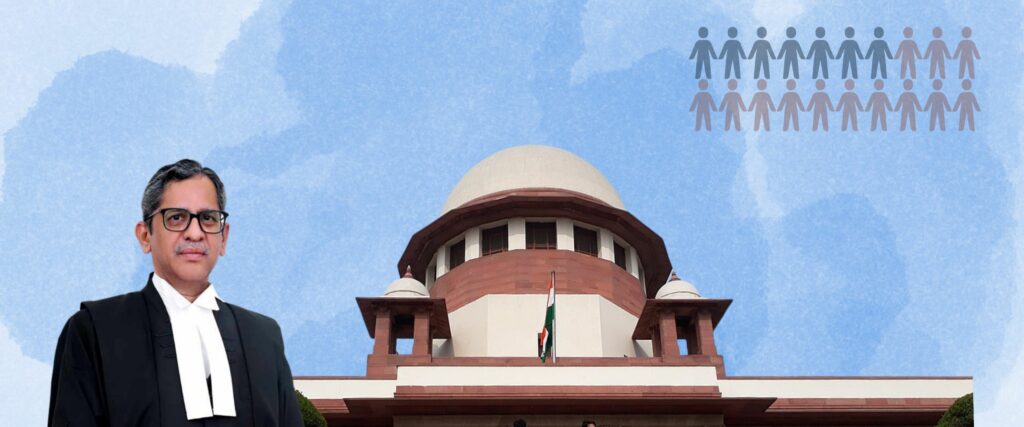Context:
Recently, a seven-judge Constitutional Bench of the Supreme Court approved the sub-categorization of Scheduled Castes to ensure that reservation benefits are directed to the most marginalized within the community.
Key Highlights of the Judgement
Schedule castes are not a homogenous class
- In a 6:1 landmark verdict, the Supreme Court held that scheduled castes are not a homogeneous class, thus sub-classification of Scheduled Castes (SCs) is permissible to grant separate quotas for more backwards within the SC categories.
- This judgement overturned the E.V. Chinnaiah vs. State of Andhra Pradesh judgment of 2004, which had previously held that SCs notified under Article 341 formed one homogenous group and could not be sub-categorized further.
States have the power to sub-classify the Presidential List
- The Supreme Court clarified that sub-classification within SCs does not violate Article 14 (Right to Equality) or Article 341 (which outlines the identification of Scheduled Castes) of the Indian Constitution.
- The majority opinion noted that Article 341 only identifies SCs and does not prohibit further categorization based on genuine needs.
- Thus, the State in the exercise of its power under Articles 15 and 16 can give more preferential treatment to more backward communities among the SC/ ST category.
Introduction of the Creamy Layer Concept
- The Supreme Court proposed that the State must evolve a policy to exclude the “creamy layer” among the SCs, similar to its use with Other Backward Classes (OBCs), in order to gain true equality.
Dissenting Opinion
- The dissenting judgement argues that any form of sub-categorization would effectively alter the Presidential list of SCs, a change that can only be made by Parliament.
- Such actions could lead to political manipulation and compromise the integrity of the SC list.
Sub-categorization
- It refers to the community/caste-wise breakdown of a reserved category (like Schedule Caste) based on various socio-economic or other criteria.
Creamy layer
- Creamy Layer, refers to a group of people within a certain caste/community who are better off than the rest based on certain criteria.
- The creamy layer concept emerged from the 1992 Indra Sawhney ruling, where the Supreme Court upheld a 27% OBC reservation (Mandal Commission recommendation), excluding more advanced members to ensure benefits reached those in greater need.
Article 341
- Article 341 of the constitution gives the President the power to create a list of SC communities for reservation.
Jarnail Singh v Lachhmi Narain Gupta (2018)
- In this landmark ruling, the Supreme Court upheld the “creamy layer” within SCs.
- It was applied to promotions of SCs for the first time in 2018.
Historical Background Regarding Sub categorization of Schedule Caste Quota
- In 1975, the Punjab government issued an executive order for giving first preference in SC reservations to the Balmiki and Mazhabi Sikh communities.
- Later, in 2000, Andhra Pradesh tried to sub-categorize the SC population through a legislative act, but this was invalidated by the Supreme Court in 2004 (E.V. Chinnaiah judgement).
- Following the Supreme Court verdict, the Punjab government policy was struck down by the Punjab and Haryana High Court in 2006 (Dr. Kishan Pal v. State of Punjab case).
- In response, the Punjab State government introduced a new bill to maintain the sub-categorization policy, but this law was struck down by the High Court four years later.
- The legal validity of SC sub-categorization ultimately reached the Supreme Court.
- The Supreme Court in Davinder Singh v State of Punjab (2020) held that the court’s 2004 decision required reconsideration.
Arguments For and Against Sub-Categorization
- Proponents of sub-categorization argue that it “rationalizes the affirmative action regime.”
- Some states have asserted before the Supreme Court that there are disadvantaged sub-groups within the SCs and that states should be permitted to address their needs.
- In contrast to the Supreme Court’s ruling in the Indra Sawhney case, which endorsed the sub-categorization of Socially and Economically Backward Classes (SEBCs) or OBCs, opponents argue that SCs are considered homogeneous groups.
- They contend that sub-dividing SCs would breach Article 341, which designates SCs as a homogeneous category for constitutional purposes.
Also Read:
Opposition moves a privilege motion against the Prime Minister

